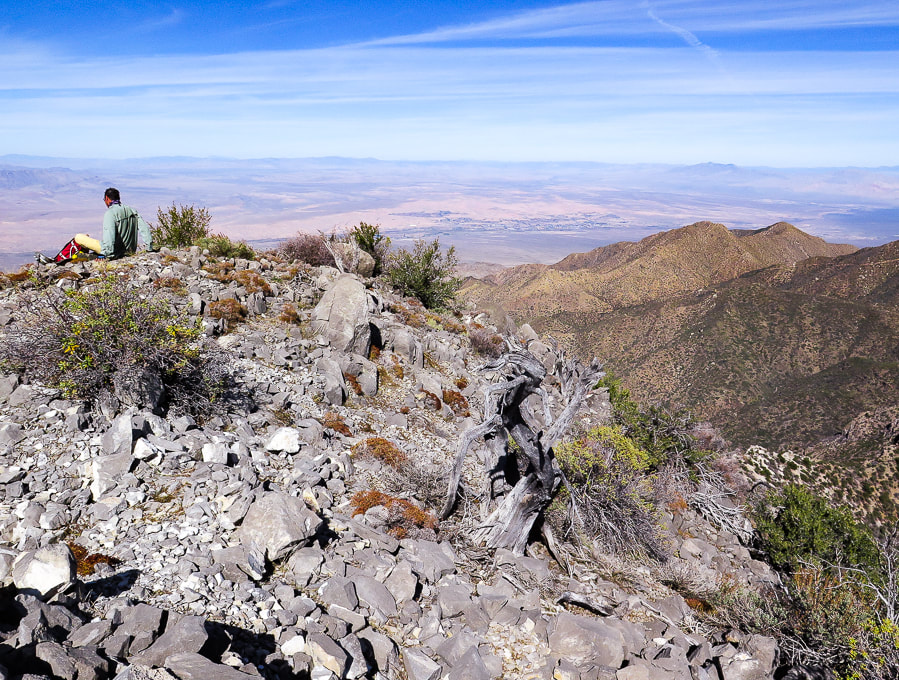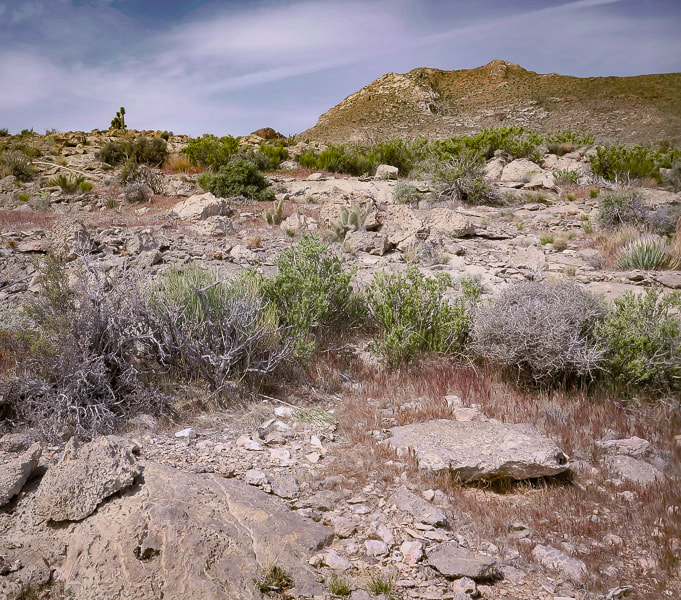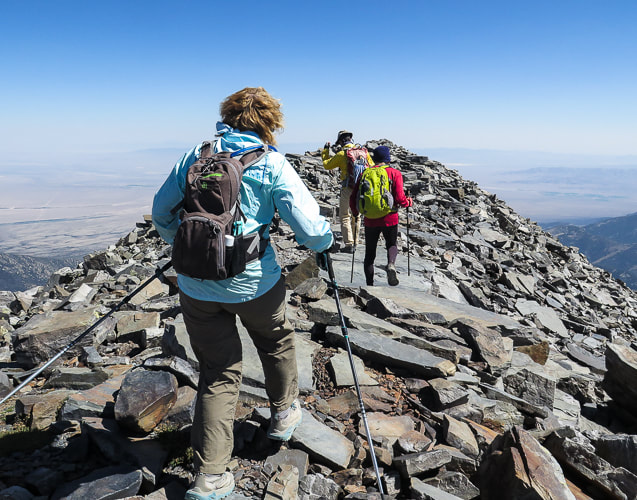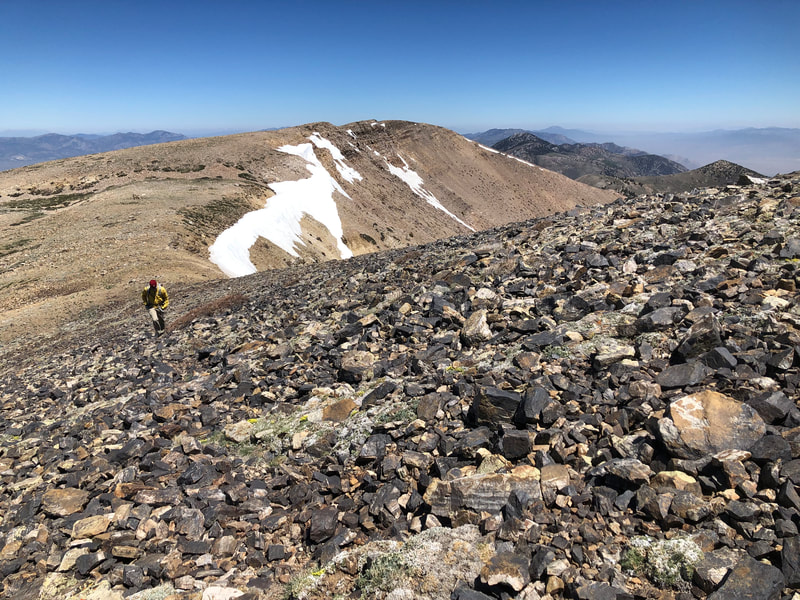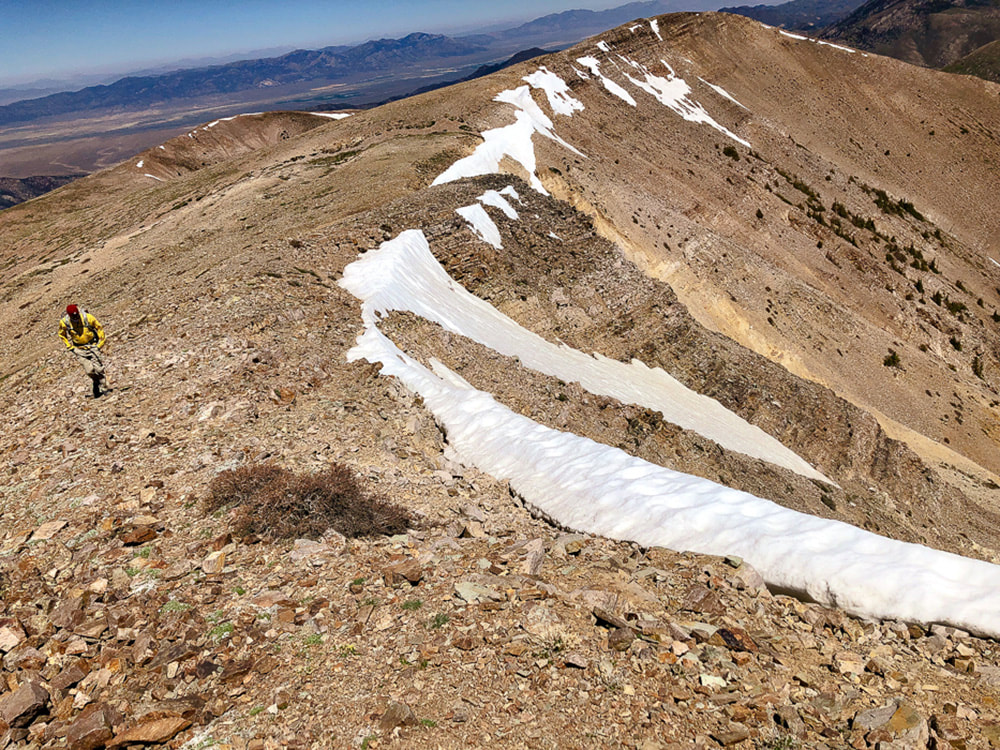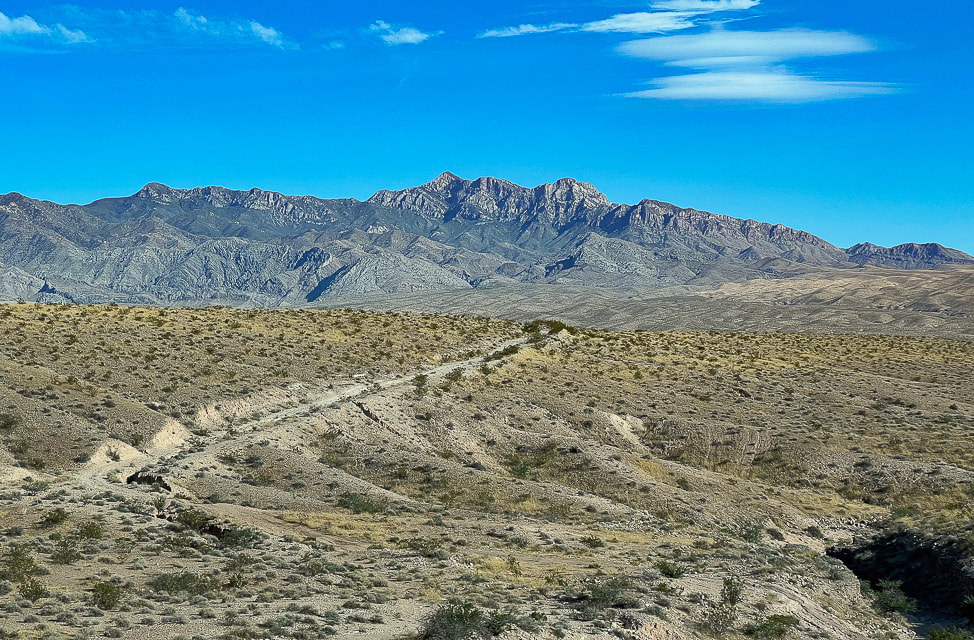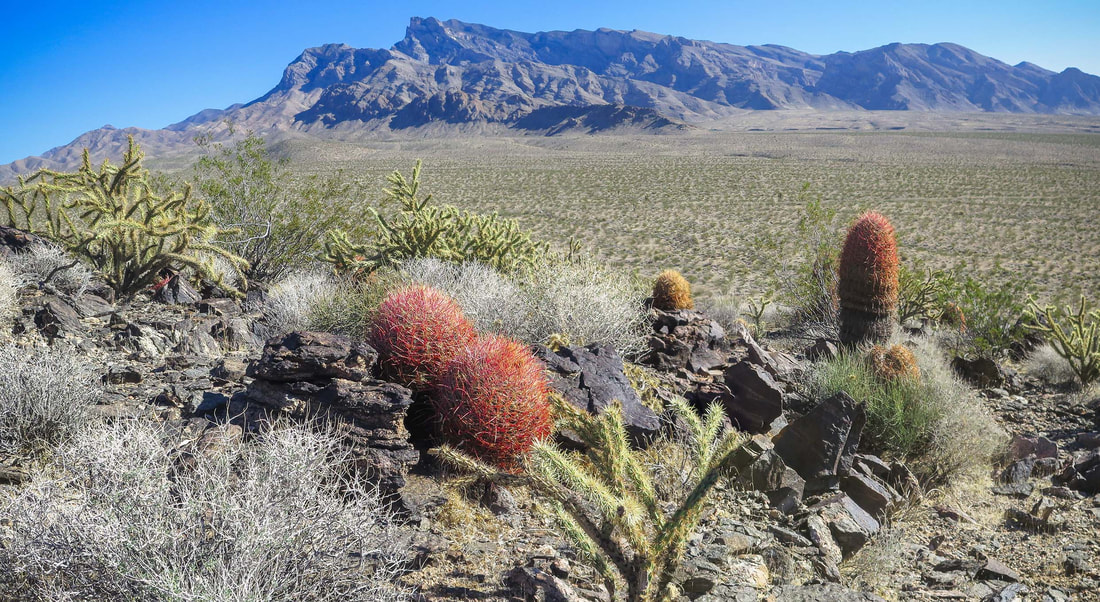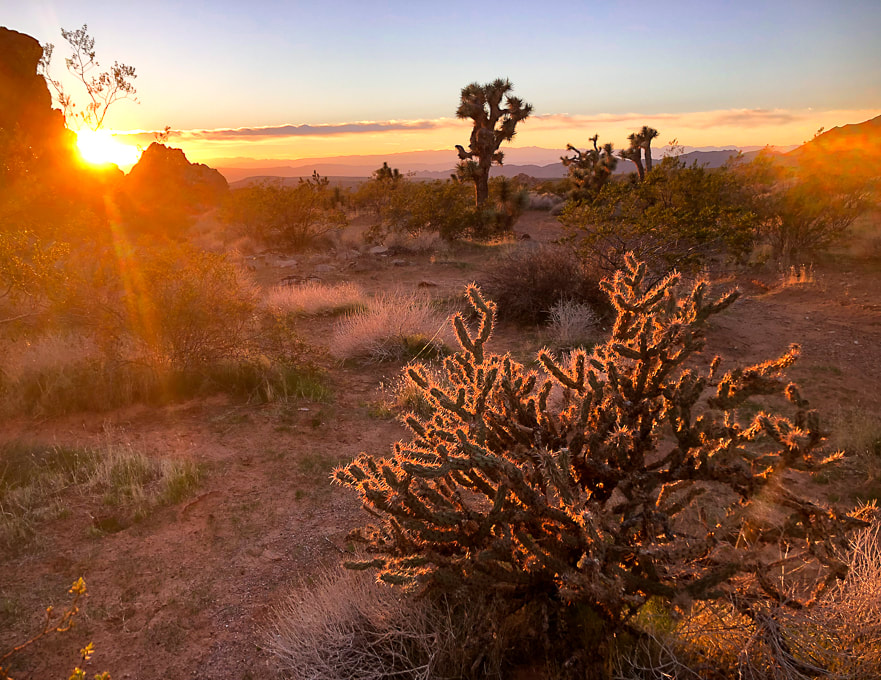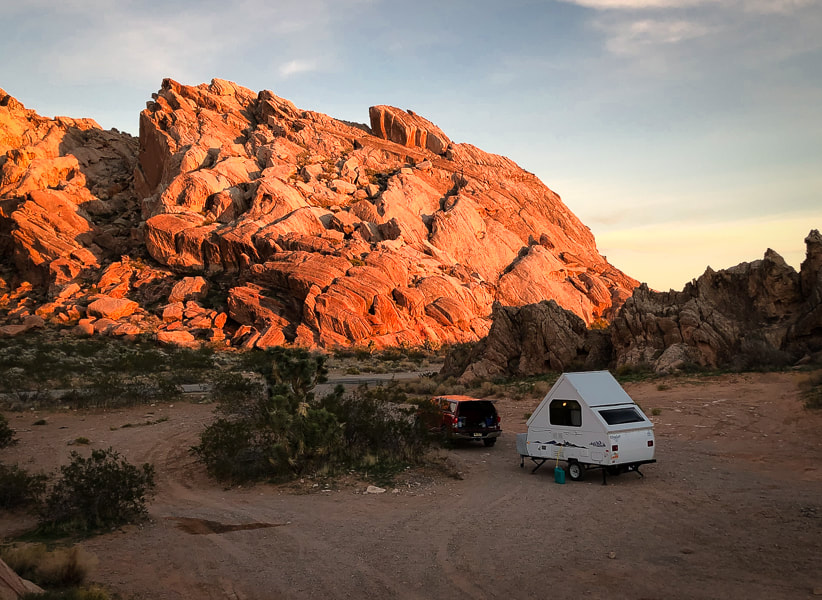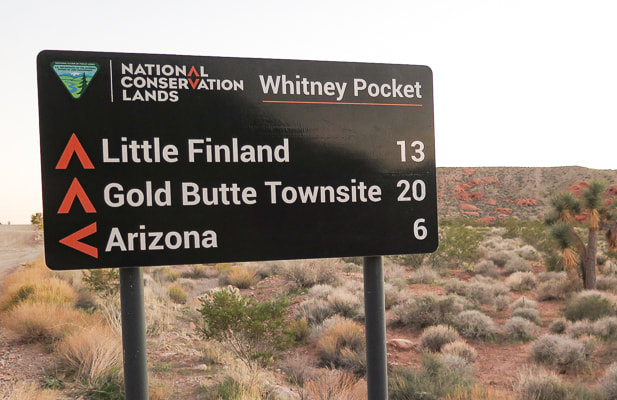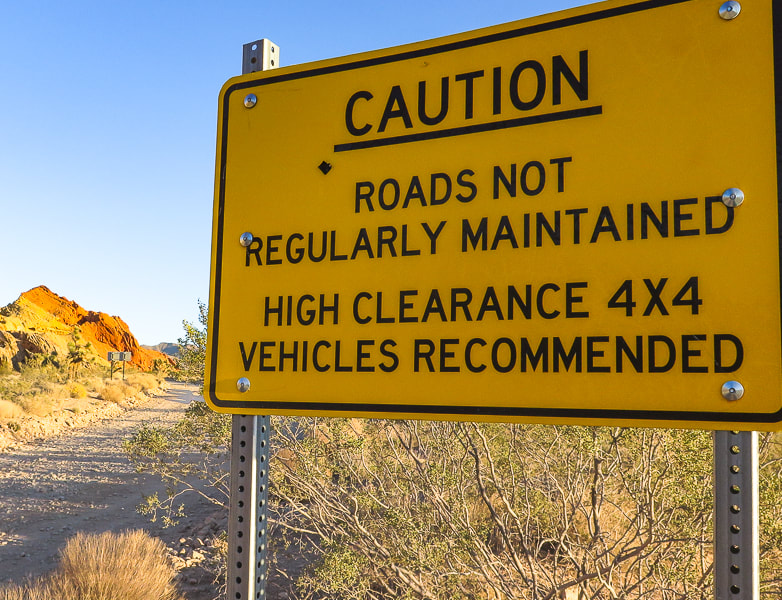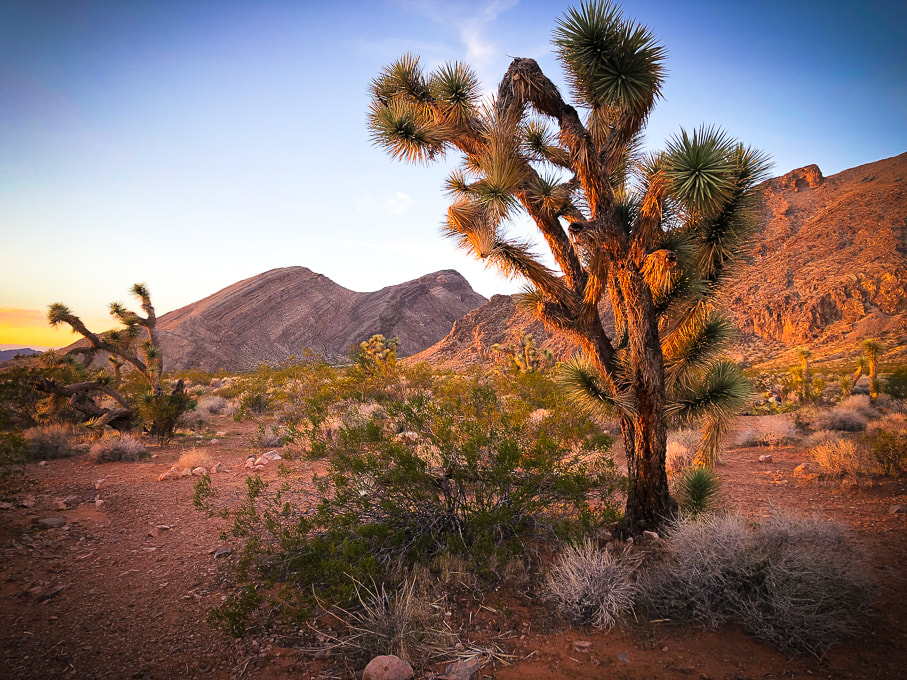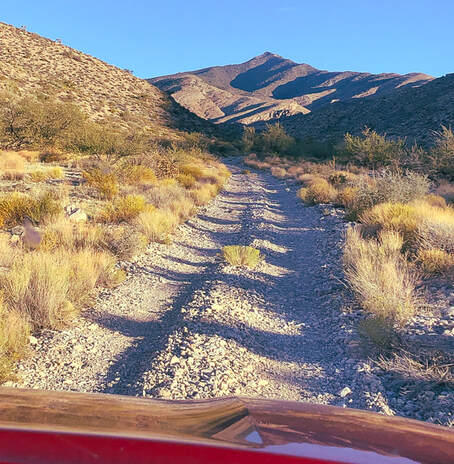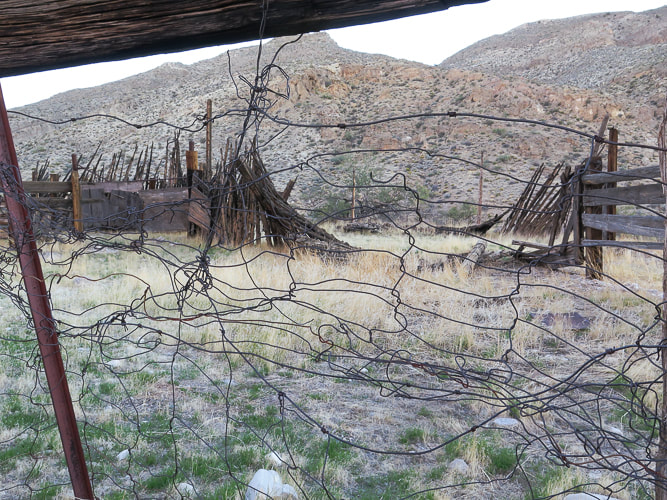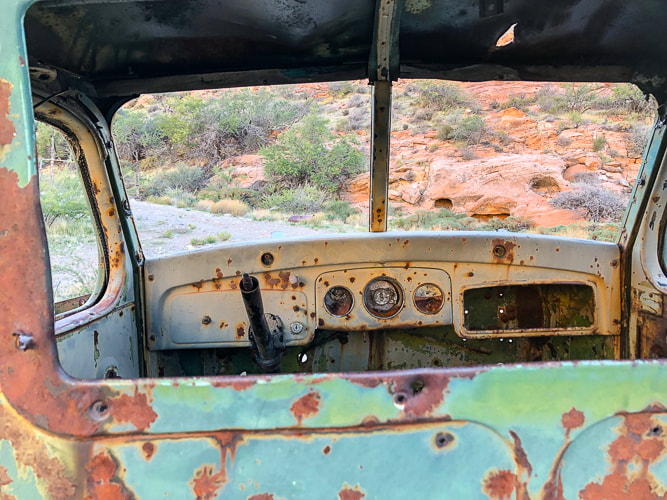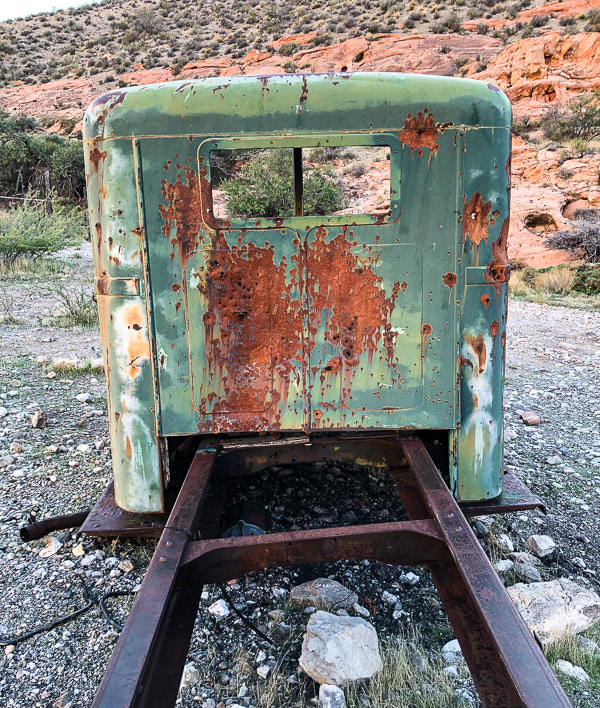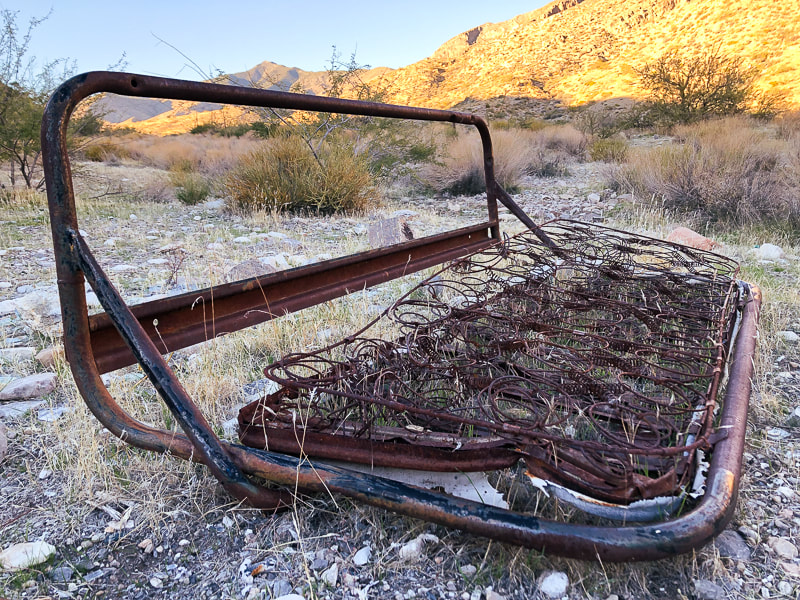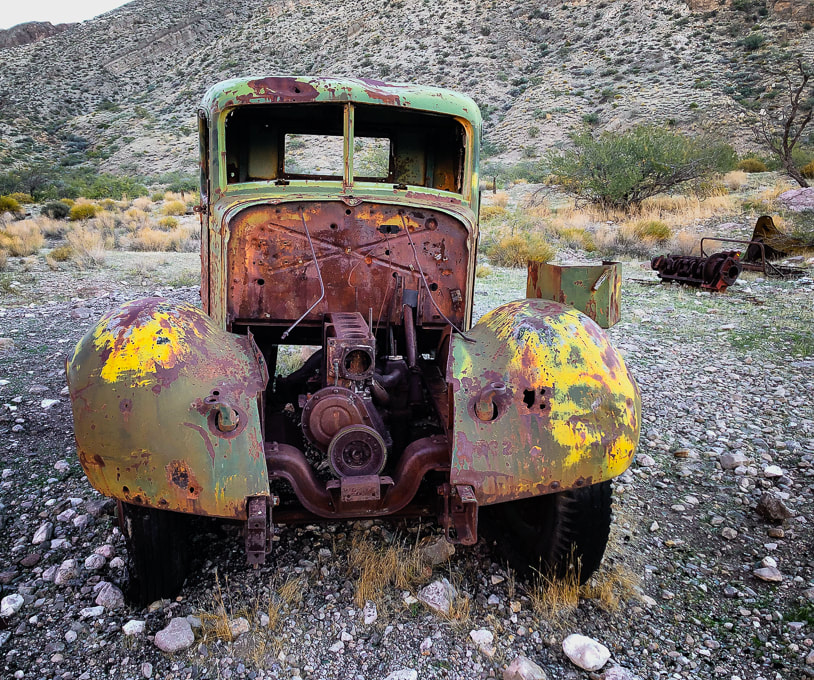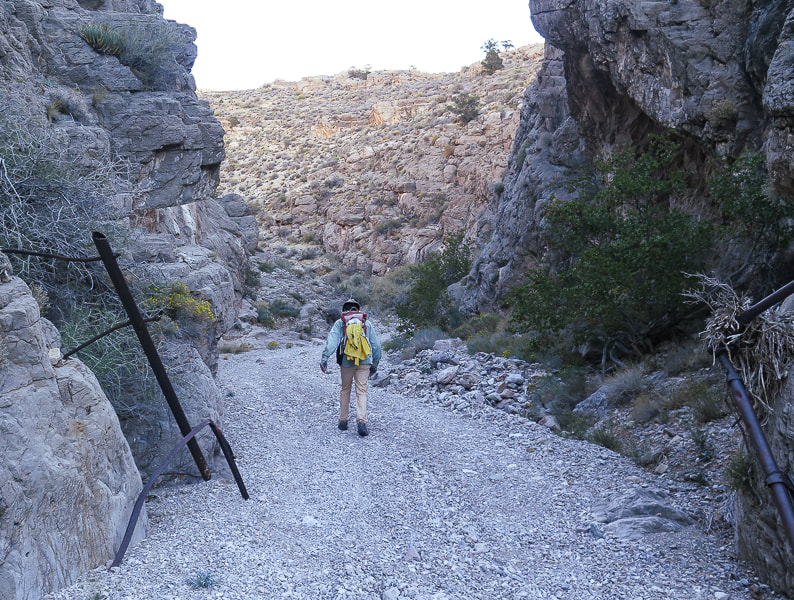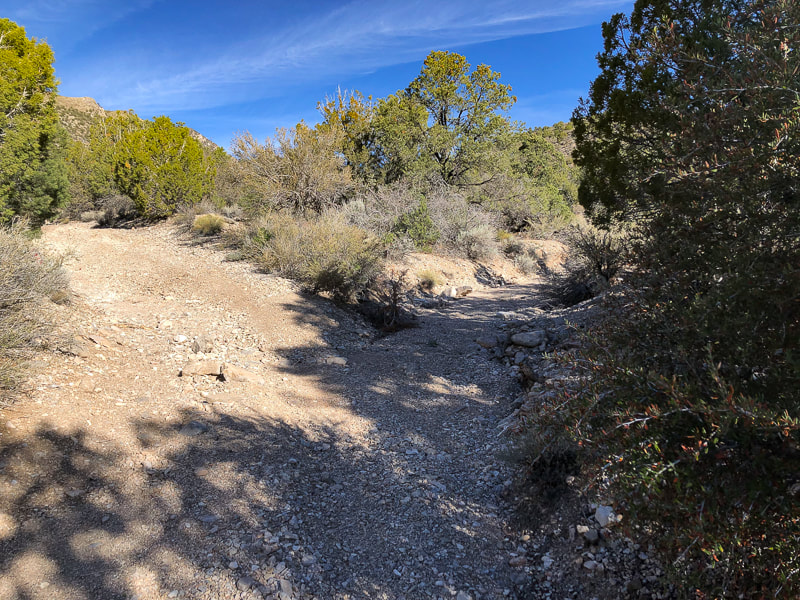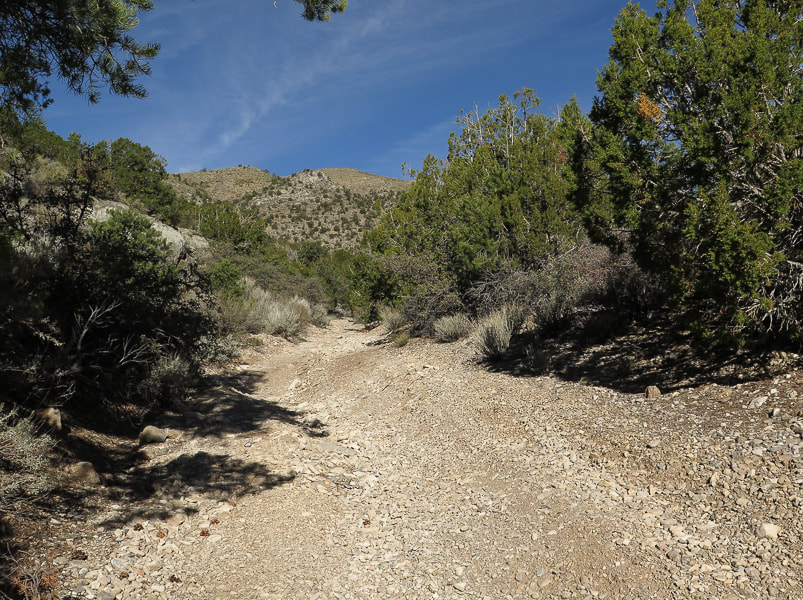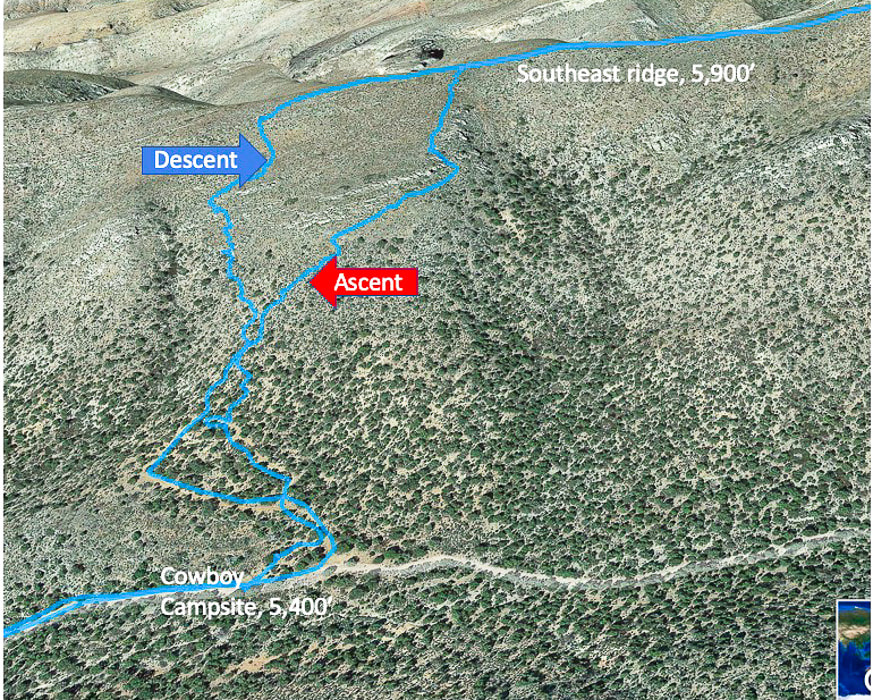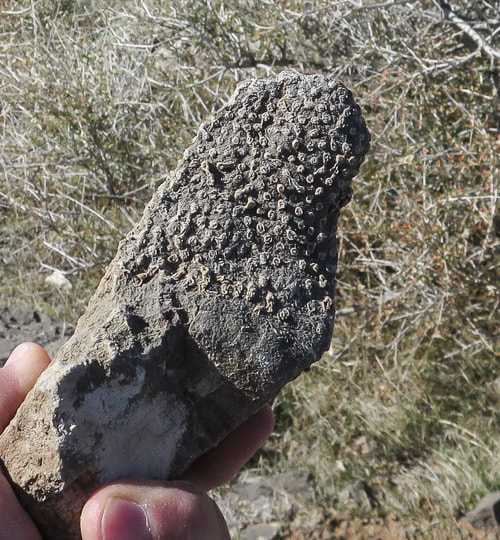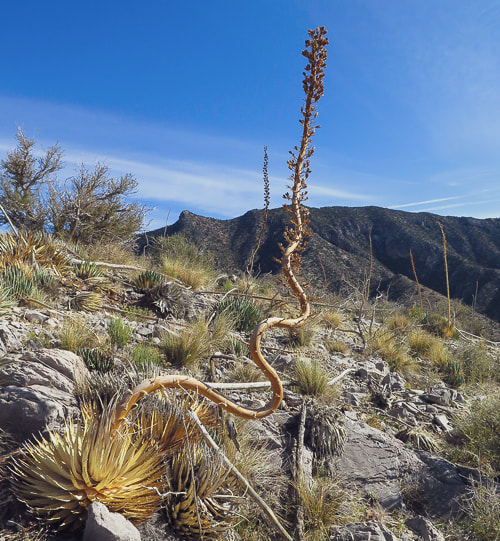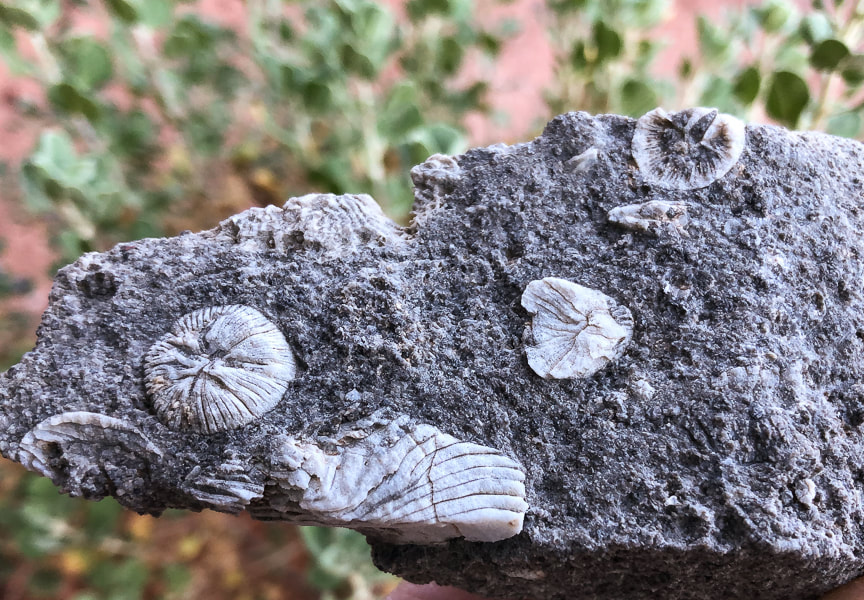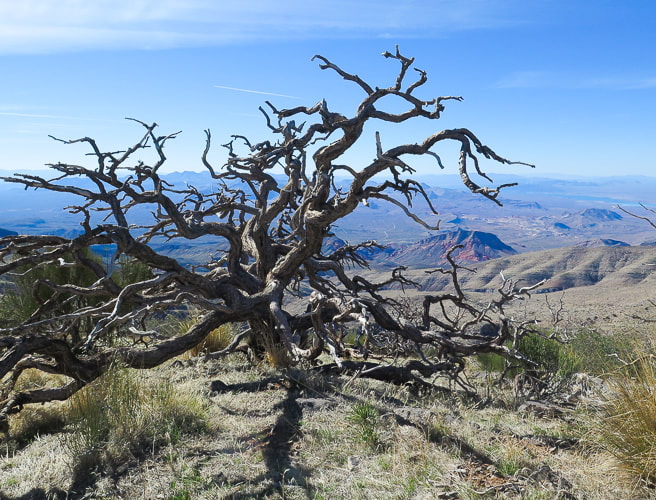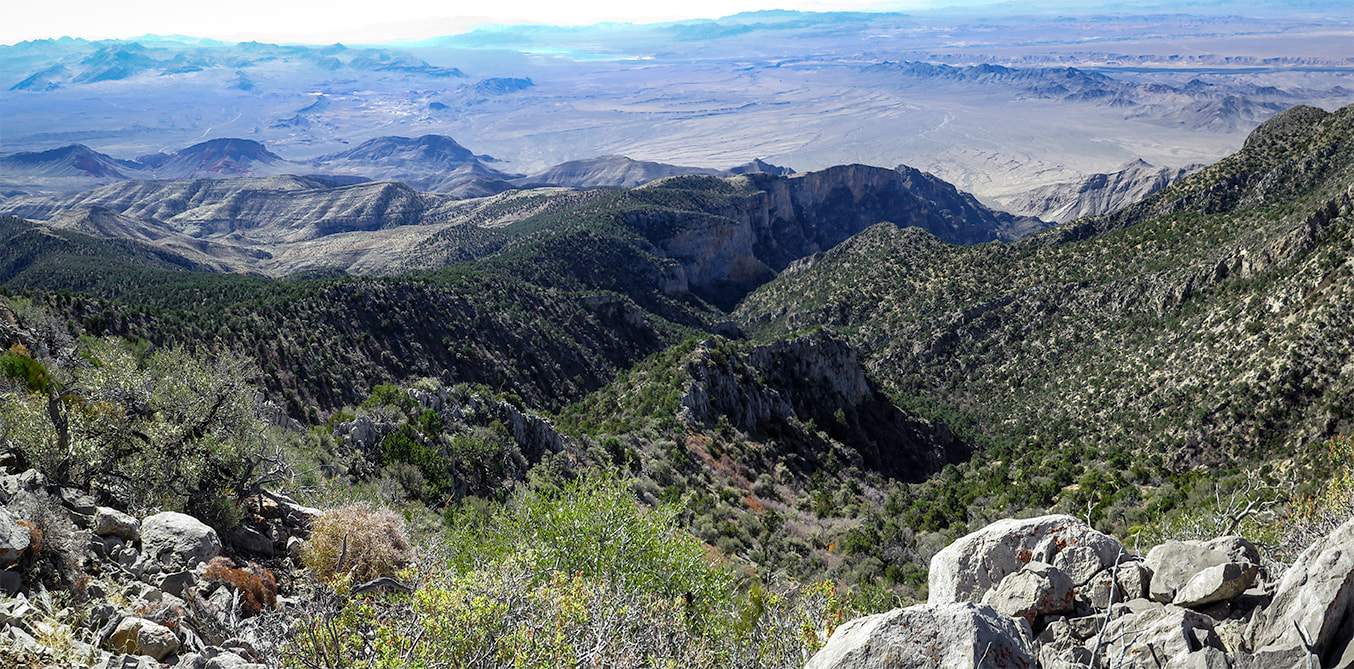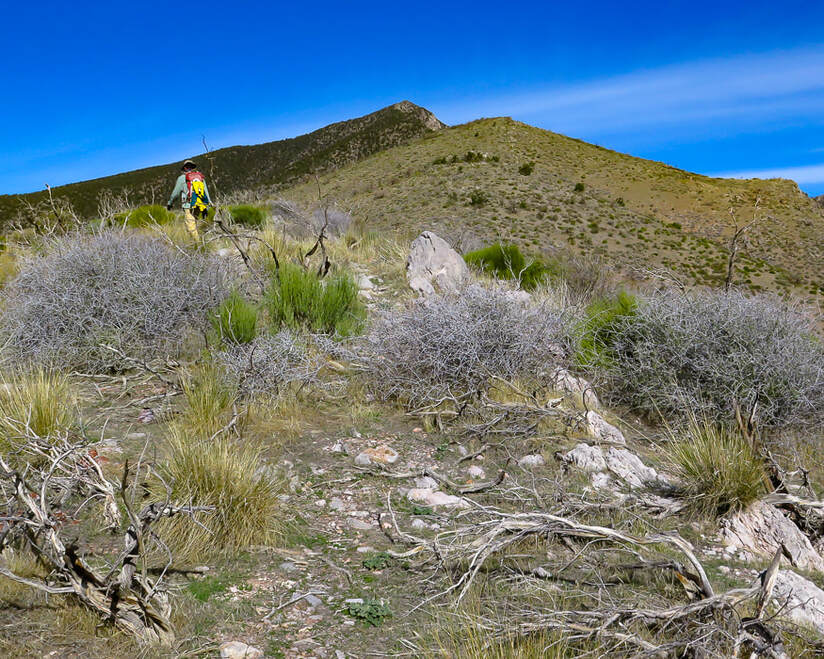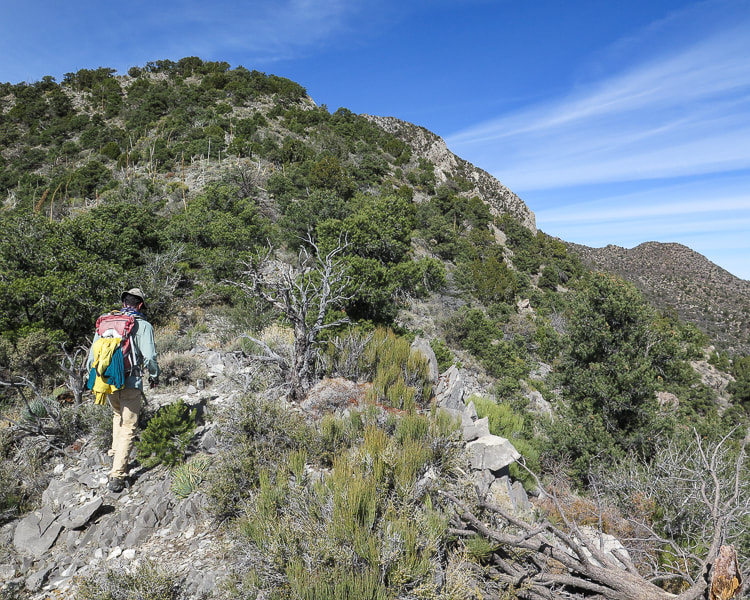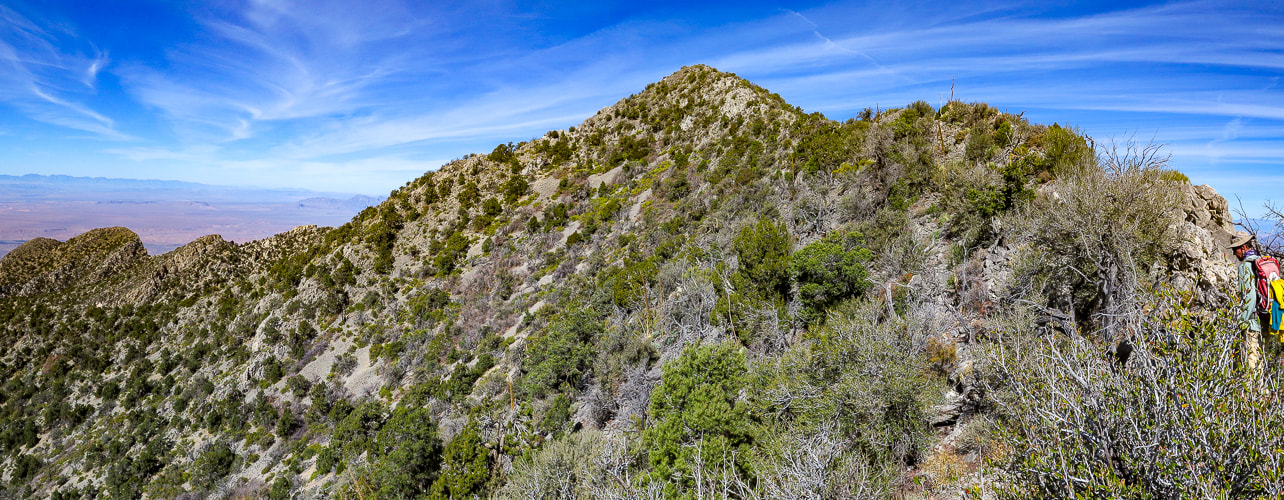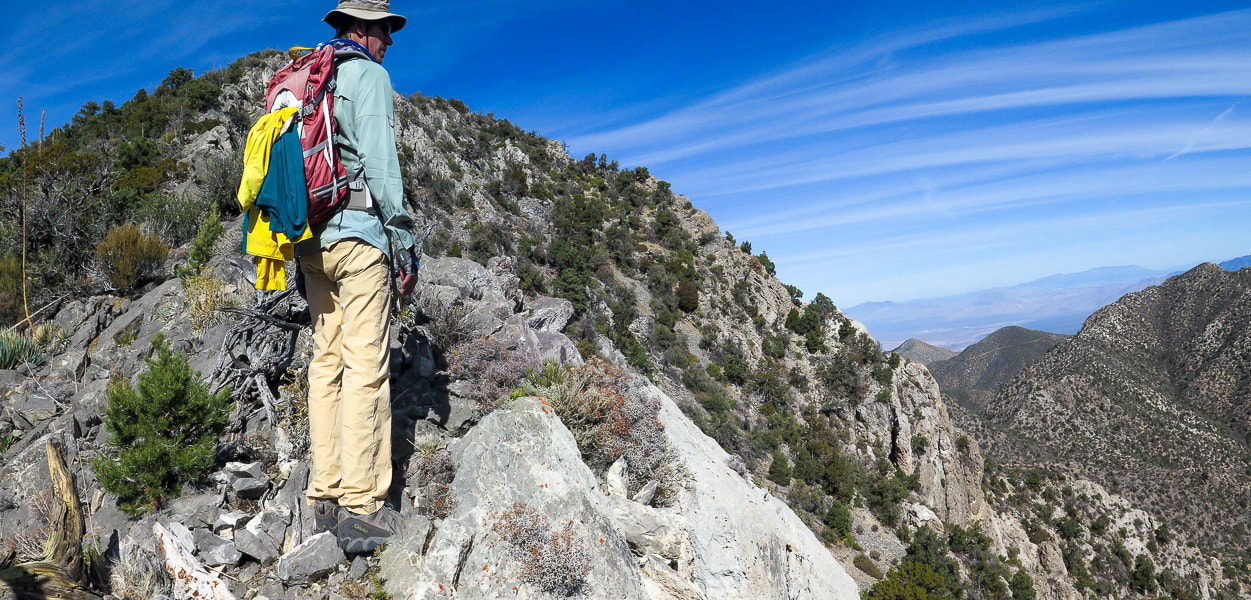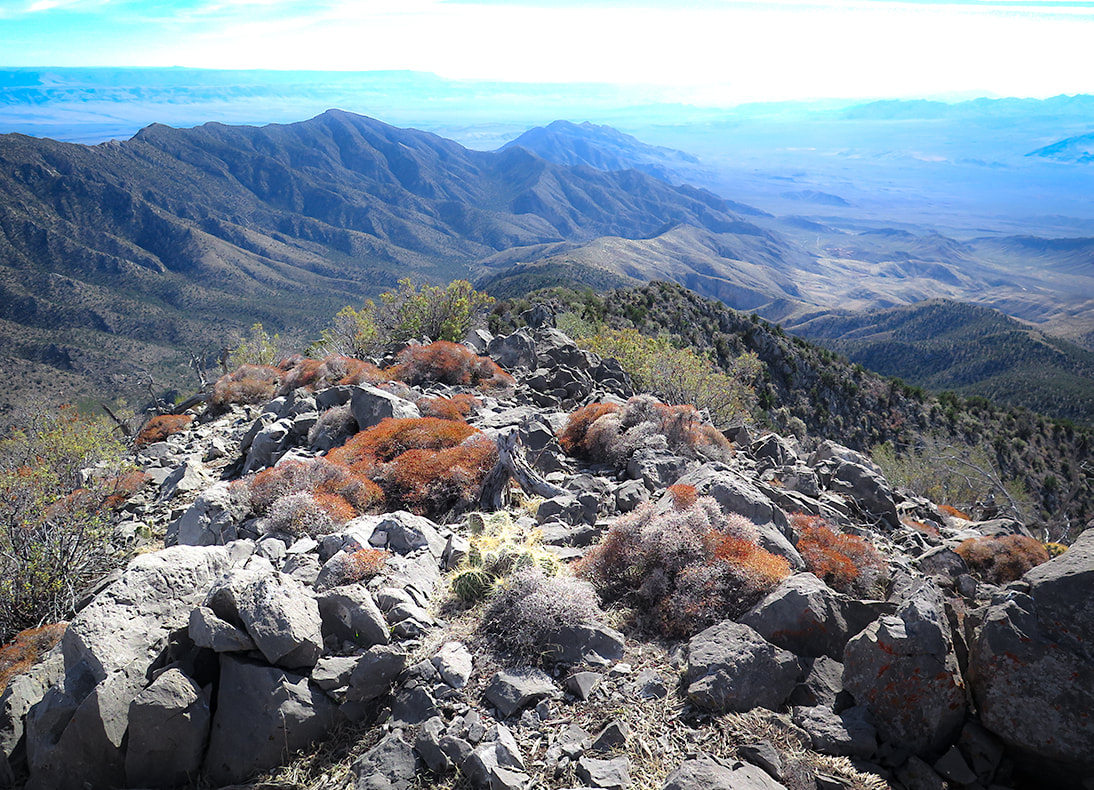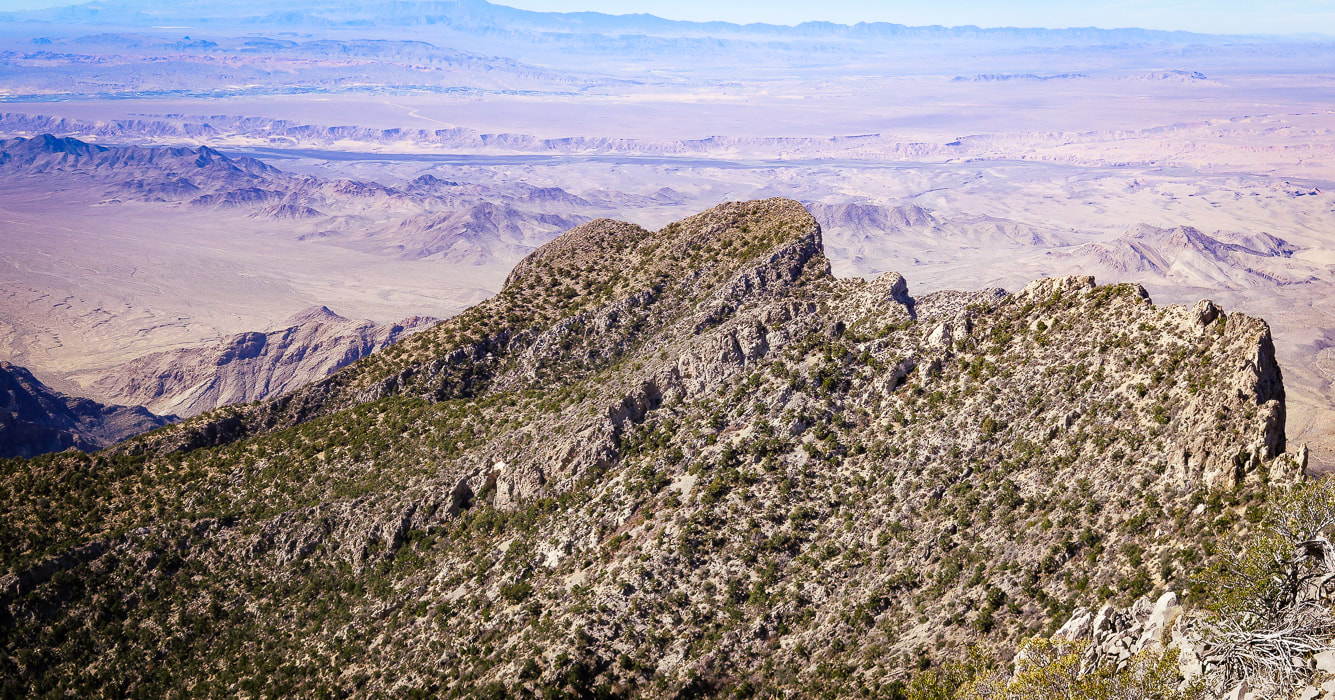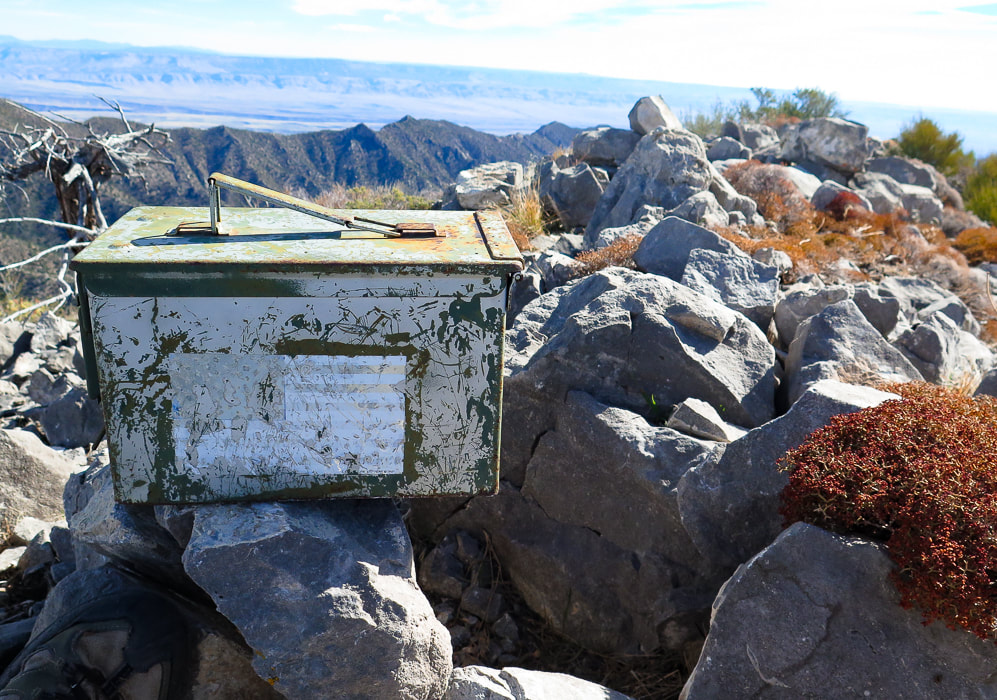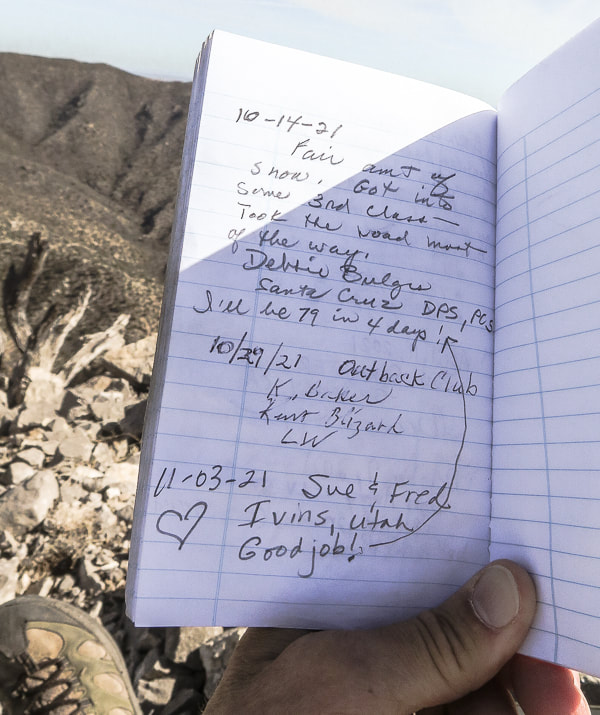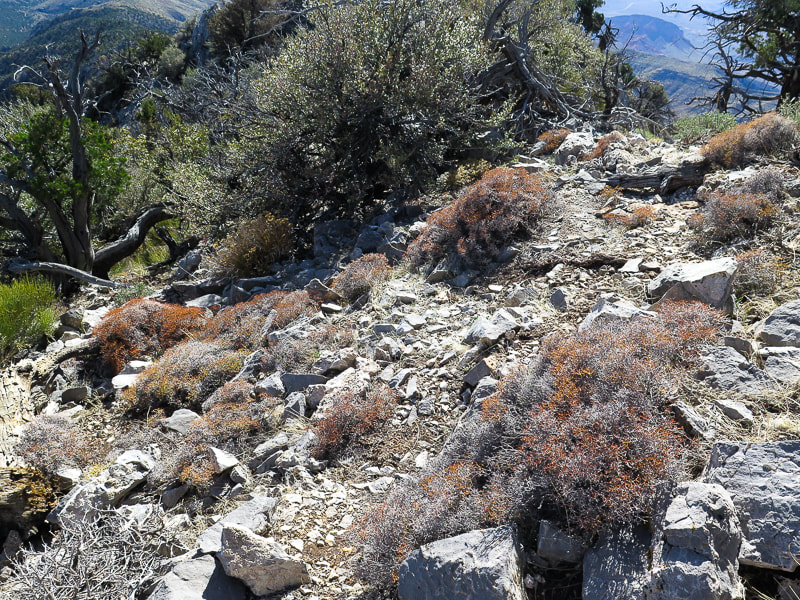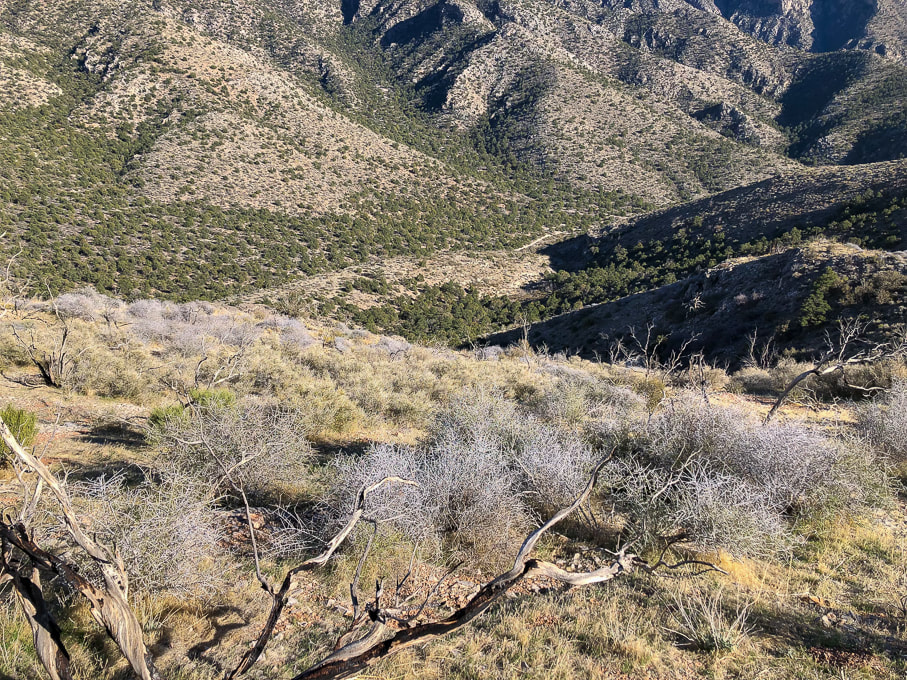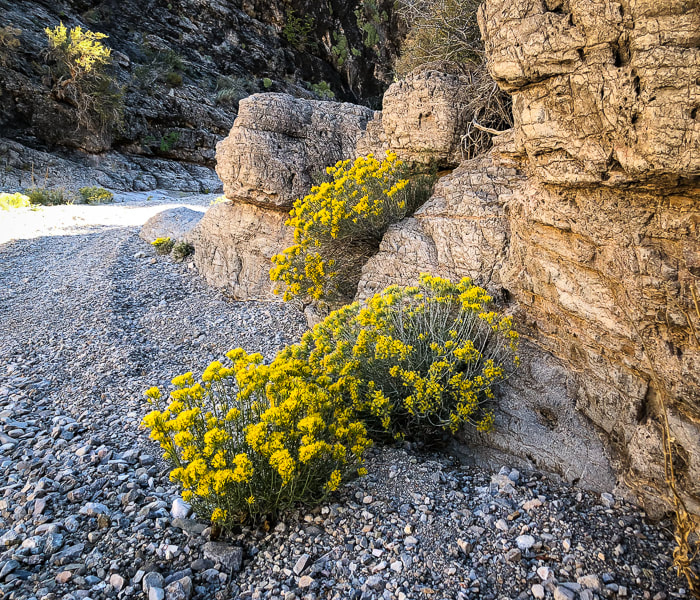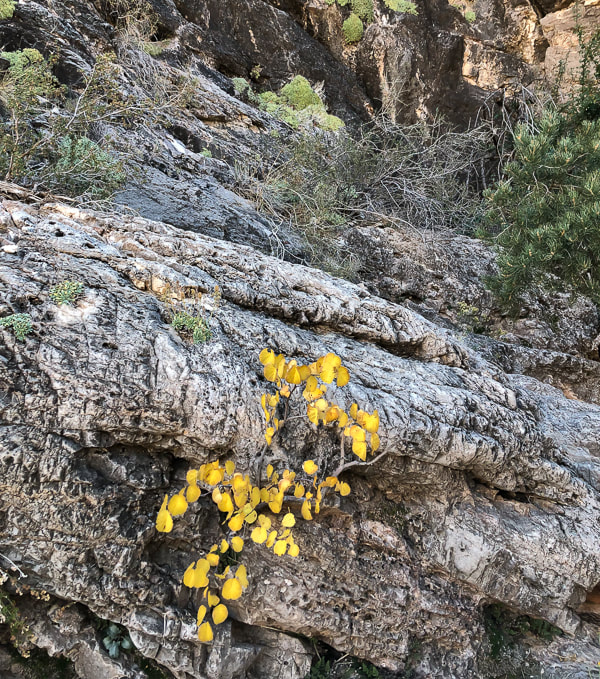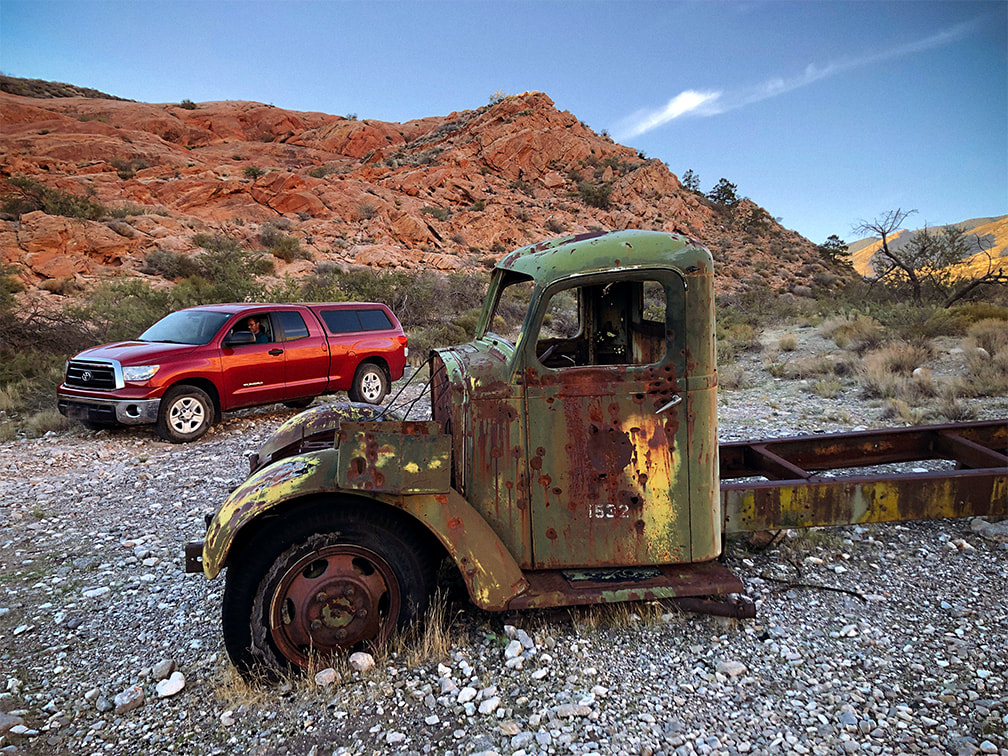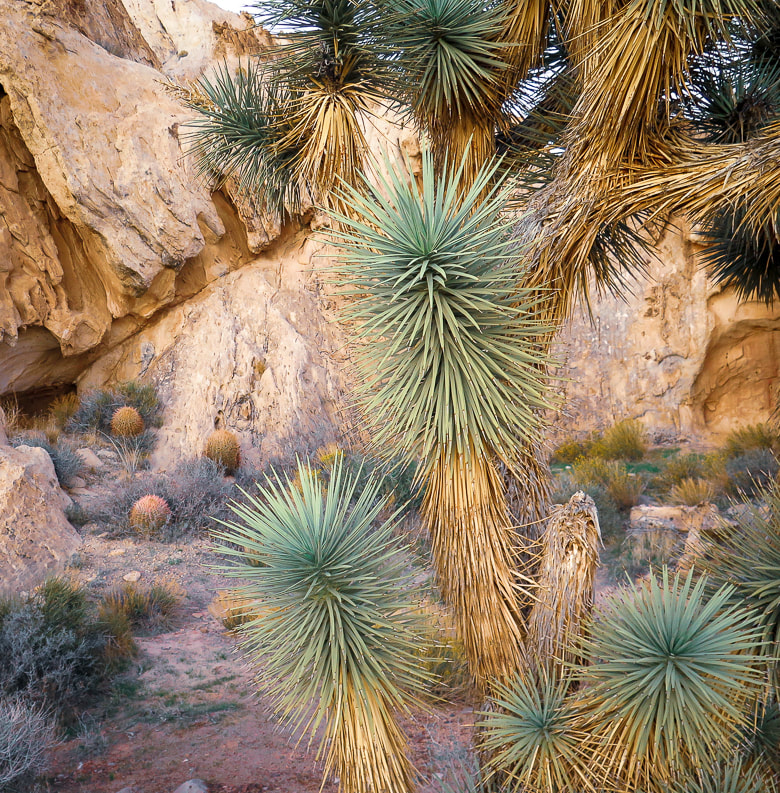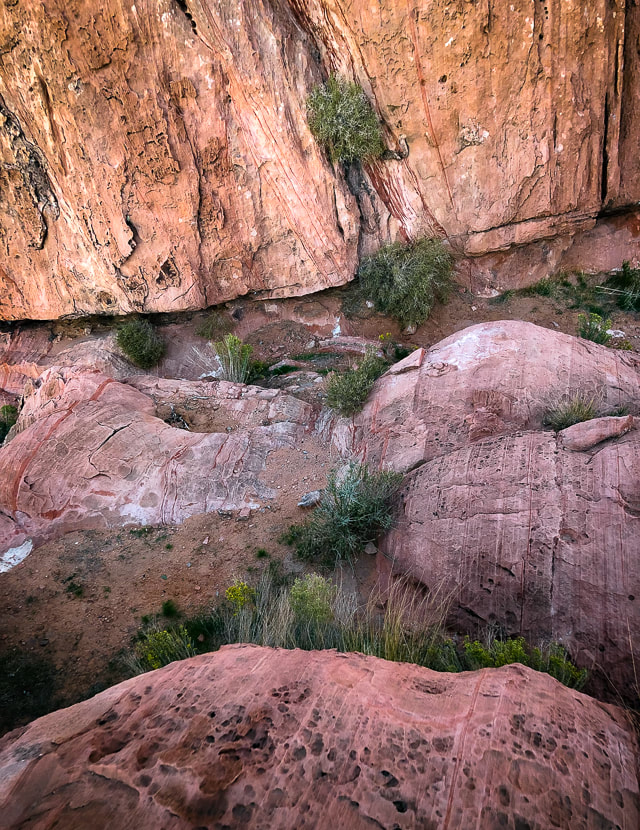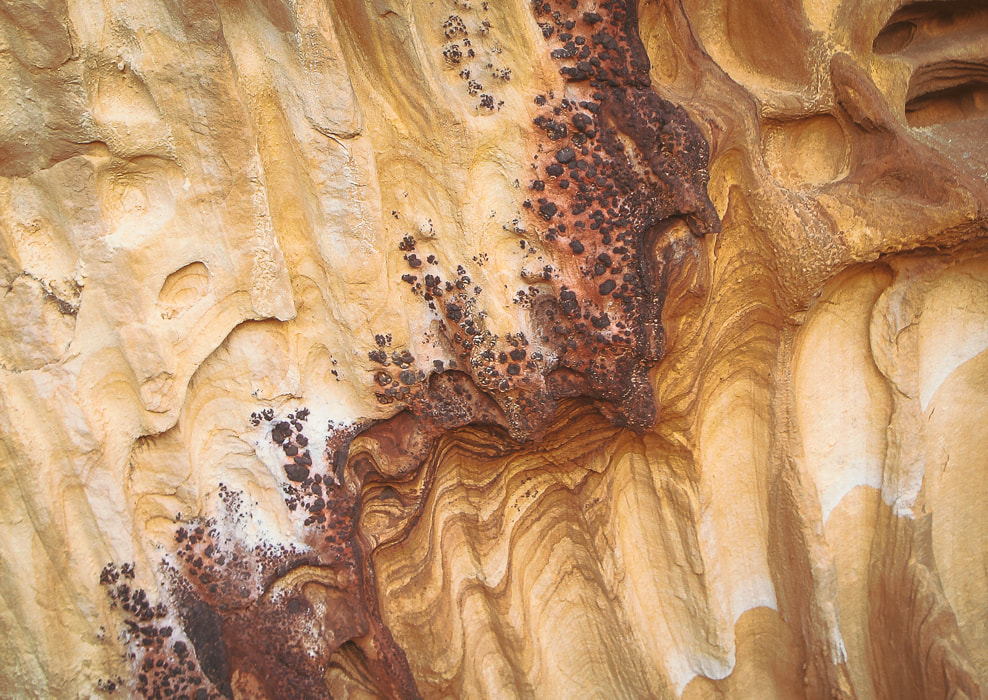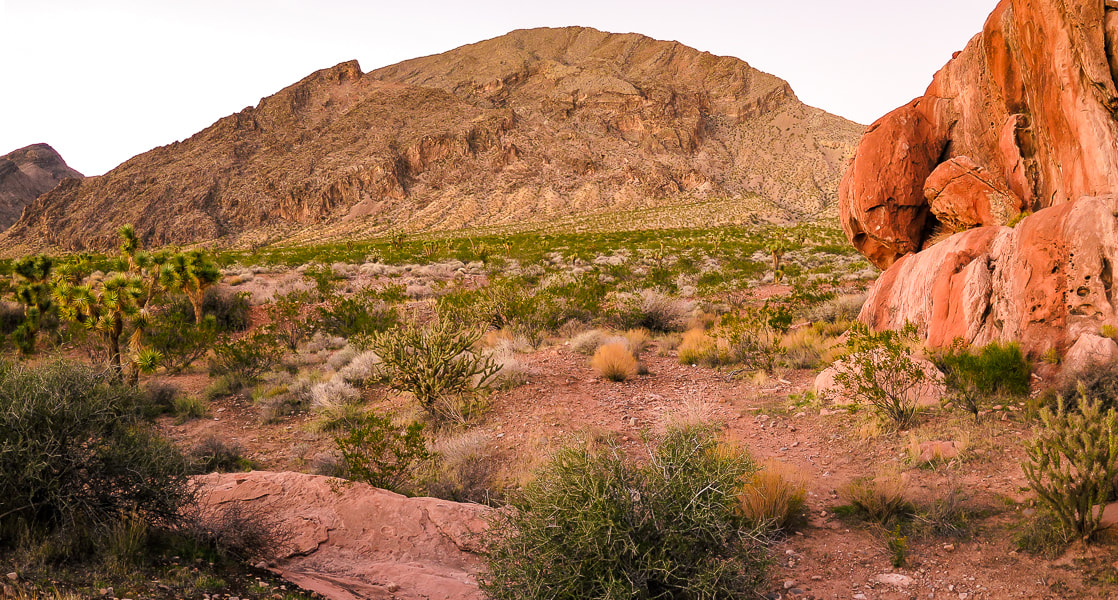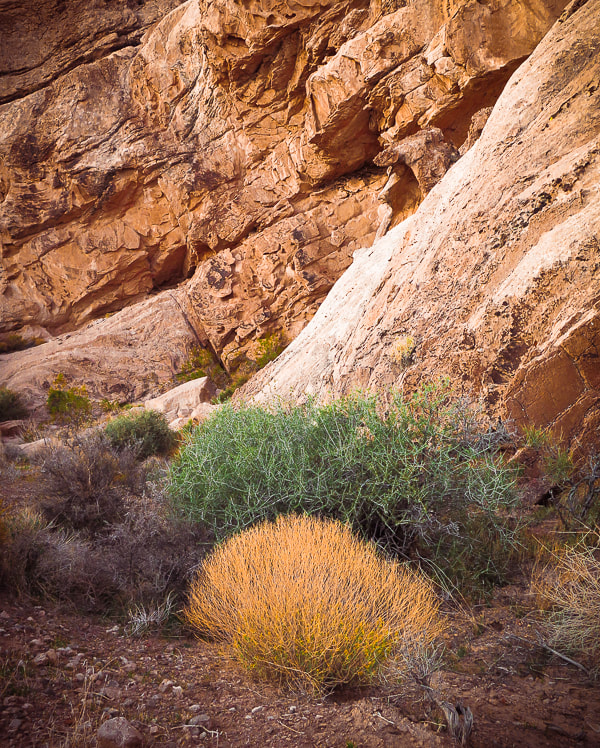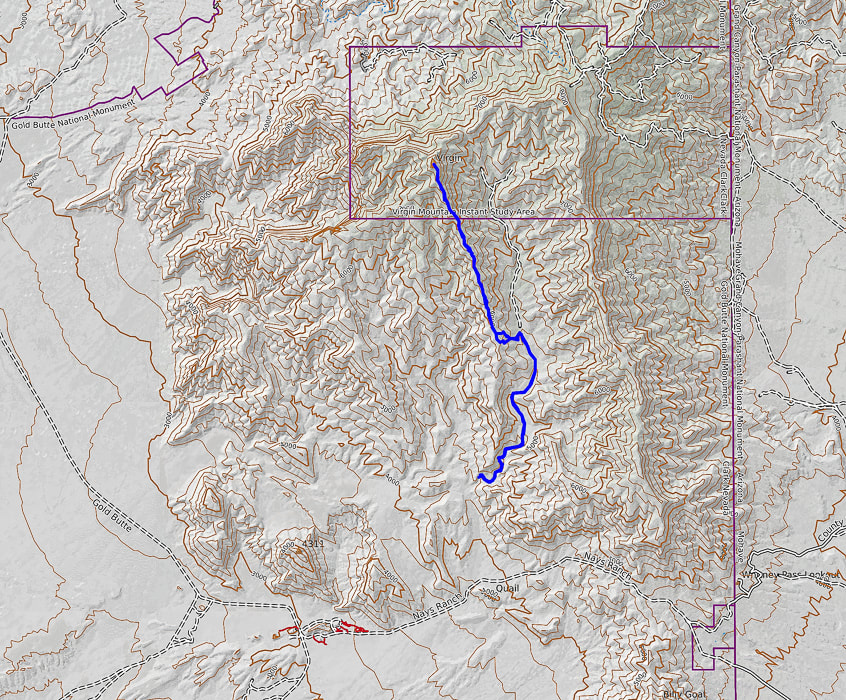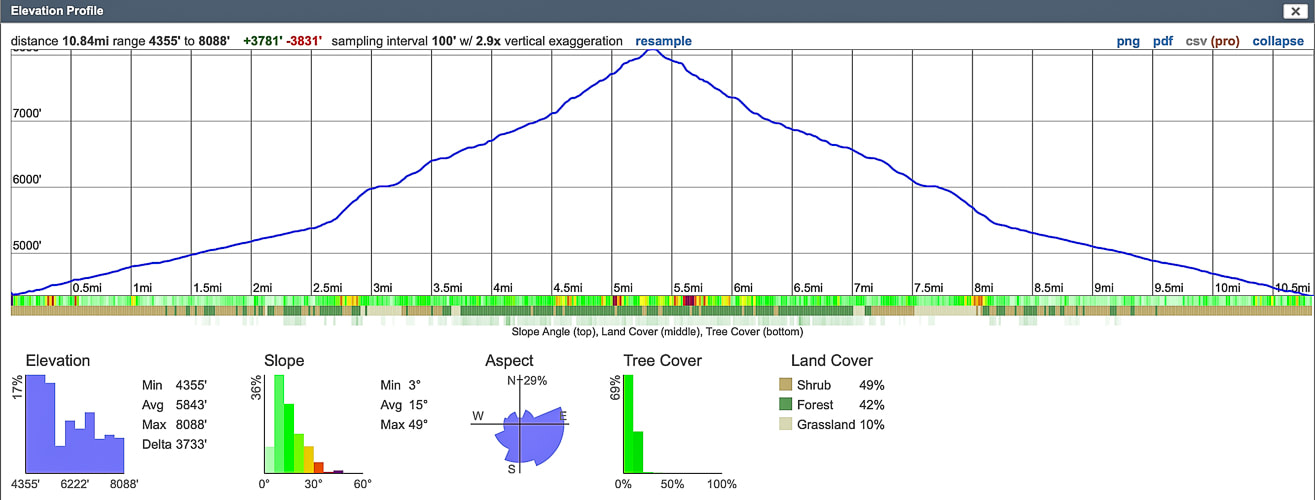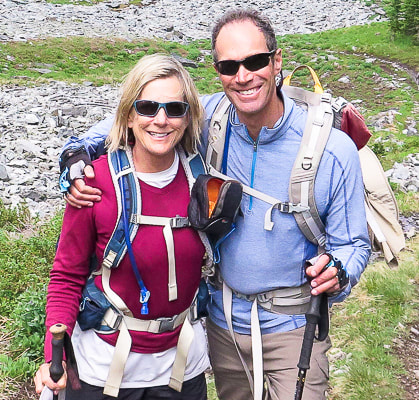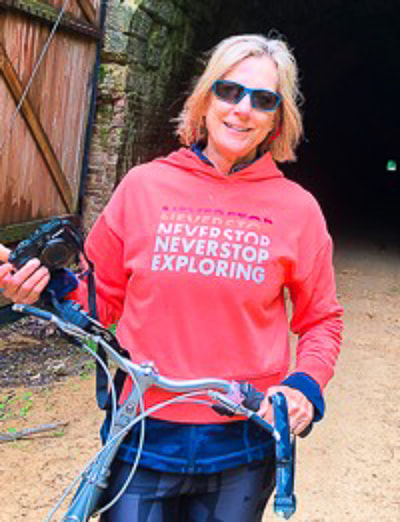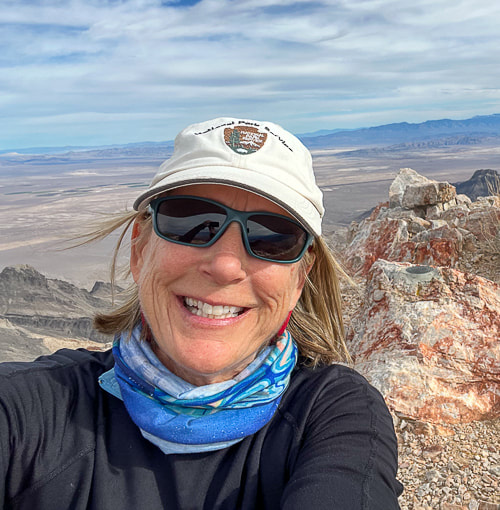|
Remote ridge ramble on fossil-filled limestone northeast of Lake Mead and south of Mesquite in Nevada. Camping the night before among the dramatic sandstone formations at Whitney Pocket in beautiful Gold Butte National Monument enhanced this experience.
Virgin Peak summit, looking north toward town of Mesquite, Nevada and Mormon Mountains on left horizon.
Trip Stats
Location/Overview: Virgin Mountains Instant Study Area, Gold Butte National Monument, southeast Nevada, northeastern edge of Mojave desert. The approach to this remote hike begins with a drive through ancient bright orange sand dunes at Whitney Pocket, rising abruptly over Joshua tree-filled valleys, providing private primitive camping coves. The southeast ridge hike has three main sections. The first is a high-clearance 4 WD road that utilizes a deep wash on the right (east) side of the ridge. Next, a steep scramble gains 500 feet from the wash/jeep road to the summit's southeast ridge where the third section is a 2.3-mile, 2,000'-gain beautiful ridge hike to the summit, with many examples of Mississippian-age fossils in limestone, and spectacular views of northern Lake Mead, Valley of Fire, Beaver Dam Mountains to the north. Distance/Elevation Gain: varies depending on how far you can drive up 4 WD road; our distance was 10.85 miles out and back. Our starting elevation: 4,355'. Summit: 8,071', for a gain of 3,700'. Difficulty: Moderate hike on 4 WD road, moderate-strenuous Class 2 ridge to summit on faint trail occasionally marked by cairns. Coordinates: See waypoints table below. Maps and Apps: Virgin Peak, Southeast Ridge - birdandhike.com, Avenza app on GPS with Arizona Strip Map, Gold Butte NM Area Map (purchased at St. George BLM). Permits/Camping: No permits or fees required. Dry camping at Whitney Pocket in Gold Butte NM. Date Hiked: November 3, 2021. Considerations: Long pants advised due to a lot of bushwhacking through shrubs and trees, exposed ridge (thunderstorms), the higher the clearance of your 4 WD vehicle, the nearer your access to trailhead at Cowboy Campsite. Geology: On southeast ridge and on summit, you will be walking on Rogers Spring Limestone AKA Monte Cristo Group (Mississippian period ~ 340 million years ago). Canyon walls on the way up to ridge are Devonian (~ 400 mya) and Cambrian (~500 mya). Geologic map of the Virgin Mountains Instant Study Area, Clark County, Nevada
Related Posts:
“The Mojave Desert is a harsh, but very spiritual, place. As children growing up in the Mojave, we chased lizards and snakes, instead of frogs and squirrels. There is an arid openness about it, and a true feeling of being alone, that you don’t get in any other type of environment.”
- James Stanford, from Shimmering Zen
Virgin Peak from Interstate 15 in Nevada.
Our Hike
In our quest this year to explore "off the beaten path" areas in southwestern Utah, away from crowded national and state parks, we have seen some sublime, amazing and sometimes astonishing wilderness beyond park borders, almost always in solitude. Last month, we explored part of the Beaver Dam Mountains. Our adventure this month landed us on the highest summit in the Virgin Mountains, a remote "sky island", rising more than 6,000 feet above the dusty desert floor of southeastern Nevada, a little over an hour's drive from Las Vegas. Extra work goes into figuring out approaches and routes to these less-traveled places, but I find this more meaningful and fun than hiking in well-traveled parks. In 1993, the first time I visited Zion National Park, there were a total of 2.4 million visitors. This year, 2021, looks like it will top 5 million visitors. When I visited Zion in May this year, I noticed the trails were much wider and literally trampled. On Virgin Peak's ridge, we had to focus on finding the trail, as it is not well-defined. I wondered, as we drove on Gold Butte Road to our camping spot from the city of Mesquite, what was so special about this area to make it a National Monument and why so many cared enough to form the Friends of Gold Butte organization. After 20 miles of driving, then suddenly coming upon Whitney Pocket, I understood why. Large, bright orange and red sandstone domes scattered about, anchored into the green creosote and Joshua tree-covered valleys. These large cross-bedded domes glowing orange in the setting sun are remnants of a huge desert formed 180 million years ago, and are the same rock unit as the cliff-forming Zion National Park sandstone. In Utah, this sandstone is called Navajo; the correlative unit of sandstone in Nevada is called Aztec.
View of Virgin Peak and its southeast ridge from Little Virgin Peak.
Mojave desert sunset at Whitney Pocket in Gold Butte National Monument, Nevada.
You can't beat the sublime Mojave Desert sunsets.
Whitney Corral - a glimpse of past ranching. The spring that once provided for cattle is reportedly dried up.
A thing of beauty - look at that patina!
Narrower, high clearance vehicles would be able to get up the road further than we did.
I used the waypoints from birdandhike.com and Avenza with the Arizona Strip Map loaded to make sure I was at Cowboy Campsite. Stay on the main road. Two spur roads take off to the right, but you want to stay left near the ridge you will be mounting. Near the Cowboy Campsite, three miles from the corral, remnants of ranching gear appear: old truck tires, water troughs, the metal skeleton of a chair and various other rusted relics and another old truck! See my waypoints table below or check out birdandhike.com waypoints.
From Cowboy Campsite you turn left onto an obscure spur road ascending toward ridge through trees and shrubs that runs southwest as you climb overlooking the canyon and road you just climbed.
Near Cowboy Campsite with view of Virgin Peak's southwest ridge to climb. Road goes left at intersection with wash.
Second Segment: Cowboy Campsite to Virgin Peak's southwest ridge.
We turned right (west) off the spur road at its highest point and started ascending through junipers and brush toward the ridge, eventually got above this forest and saw limestone cliffs at ridgeline. The climb is 500 feet in ~ 0.3 miles. We hiked to the right of the cliffs to get onto the ridge instead of hiking to the lowest point on the ridge to the left of cliffs. We did, however, descend on our way back from the lowest point on the ridge down to Cowboy Campsite.
Ascent/descent from Cowboy Campsite and 4 WD road to Virgin Peak's southwest ridge. Ascended right tracks, descended left tracks. Top of map is west, ascend ridge walking west, then turn north to hike to summit.
Some Cool Stuff on the Trail
On Virgin's ridge: lots of fossils including brachiopods and corals, a small burn area probably from 2020 fire caused by lightning. I believe the upper right plant is a Utah agave; I have never seen a flower stalk quite like that before!
Final Segment: Ridge to Summit
Once on the ridge, follow it 2.3 miles to the summit. The view to the west opens up; Lake Mead is seen (it looks really low) as you ascend the ridge. The ridge heads north to the summit. Wide at first, the ridge narrows and becomes steep to its right (east) side as you ascend. A trail can be seen, especially as you get toward the summit. There are numerous fossils including brachiopods and various corals. Occasionally the light-colored summit is seen behind other "pseudo" peaks or high points on the ridge. There are a few trails that lead downward off the ridge; try to stay on top of the ridge or slightly below it to the west. You will do a fair amount of bushwhacking through trees and cacti. There are a few times hands are used to maneuver up/down rocks. From the summit, the small city of Mesquite, Nevada is due north. The yellow sand washes of Arizona's western Grand Canyon-Parashant National Monument spread to the east. Lake Mead, the largest U.S. reservoir that supplies water to 40 million people, is a small blue line to the southwest. A good view of Pleistocene relict Douglas fir forests are seen in isolated patches just below on Virgin's northeast ridge. The peak's register contains a few small notebooks - one from the Desert Peaks Section of the Sierra Club inside an old ammo box. Two other groups had signed it in October. One of the entries proclaimed, "I'll be 79 in 4 days!". Remarkable. I hope I will be able to write that entry into a remote peak register some day, far above the desert floor.
View of Lake Mead to the southwest at top of image.
A view of Virgin Peak ahead.
One last rise to climb before the final summit climb (just to the right of this rise).
Getting up there! Ridge is a series of rises.
The last climb to the summit over increasingly steep and rocky terrain - just under 8,000 feet here.
Virgin Peak summit looking south: South Virgin Peak Ridge on the left, Whitney Ridge behind it, Arizona top of image.
Tilted limestone beds to the west.
Virgin Peak register box.
Summit register: an official Desert Peaks Section of Sierra Club notebook.
Solitude in the Mojave Desert
One of the great American nature writing classics, The Desert: Further Studies in Natural Appearances by John C. Van Dyke has been in continuous publication since 1901. Through his descriptions of his travels in the deserts of California, Arizona and Mexico, Van Dyke changed the popular perception that the desert was a hostile wasteland. The book is a bit monotonous, like Thoreau's On Walden Pond, but Van Dyke helped us to see and appreciate the remarkable beauty of deserts. I can relate to his quote and falling in love with what I call "the desert":
"The weird solitude, the great silence, the grim desolation, are the very things with which every desert wanderer eventually falls in love. You think that strange perhaps? Well, the beauty of the ugly was sometime a paradox, but to-day people admit its truth; and the grandeur of the desolate is just as paradoxical, yet the desert gives it proof."
After seeing no one else on the trail, having our own private camping spot the night before, and walking through a few life zones gaining almost 4,000 feet to look over mountains and valleys, we felt as light and as "in balance" as the surrounding environment, in-tune to the rhythms of the living desert. Each hike and each peak has its own personality, and once you understand the desert's "personality" and ways that its plants and animals survive harsh conditions, you can oftentimes relate and then be amazed. What a great way to reset and rejuvenate and relax. We are lucky to live in America's southwest desert in which there are many places to find abundant peace.
Never Stop Exploring Nature!
On the way down
Near point on ridge to descend to Cowboy Campsite in wash below.
Signs of autumn on the way down.
The new and the very old.
Joshua trees at Whitney Pocket.
Detail in sandstone at Whitney Pocket
Iron oxide concretions caused by precipitation of iron in paleogroundwater through sandstone
At Whitney Pocket in Gold Butte National Monument: Younger orange sandstone and very old limestone ridge on each side of a cholla and joshua tree-filled valley.
Our GPS tracks and profile. Top of the map is north.
References
The Geology of Gold Butte National Monument - a thumbnail sketch. Friends of Gold Butte.org. Geologic Formations of Utah. Navajo Sandstone. UtahGeology.com. Recreation visits by month, Zion NP. nps.gov. Hiking around Las Vegas and Gold Butte National Monument. birdandhike.com Lake Mead Drops to a Record Low. NASA Earth Observatory. Stringfellow, J. 2015. John C. Van Dyke and the Desert Wasteland. mojaveproject.org. Whitney Pocket. The American Southwest.
7 Comments
Lynn K
11/26/2021 09:36:18 pm
What a wonderful place! Thanks for sharing your adventures there!
Reply
Hi Lynn!!
Reply
Linda Paul
11/27/2021 02:03:42 pm
You are very good and locating and venturing into the off the beaten path spots, which is a real blessing these days.
Reply
Hi Linda,
Reply
Pam Mueller
3/29/2022 06:45:04 am
What a great article about your trip. We are going in a week. It will be our first trip. Not sure we will climb the peak but we will definitely hike. We're both 75 and will have our 3 year old Australian Shepherd with us. Thanks for the beautiful pictures too.
Reply
Pam,
Reply
Pam Mueller
3/29/2022 11:17:33 am
Thank you! Leave a Reply. |
Categories
All
About this blogExploration documentaries – "explorumentaries" list trip stats and highlights of each hike or bike ride, often with some interesting history or geology. Years ago, I wrote these for friends and family to let them know what my husband, Fred and I were up to on weekends, and also to showcase the incredible land of the west.
To Subscribe to Explorumentary adventure blog and receive new posts by email:Happy Summer!
About the Author
|
